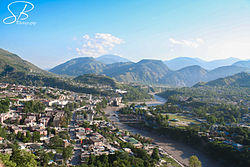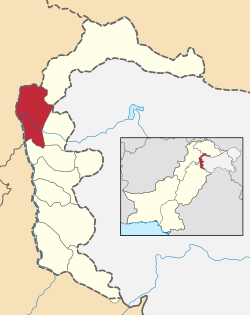Muzaffarabad District ضلع مُظفّرآباد | |
|---|---|
 The city of Muzaffarabad, Azad Kashmir | |
 Map of Azad Kashmir with the Muzaffarabad District highlighted in red | |
| Sovereign state | |
| Dependent territory | |
| Division | Muzaffarabad Division |
| Headquarters | Muzaffarabad |
| Government | |
| • District Nazim | Harris Bin Munir |
| • District Naib Nazim | N. Usama Latif |
| Area | |
| • Total | 1,642 km2 (634 sq mi) |
| Population (2017) | |
| • Total | 650,370 |
| • Density | 396/km2 (1,030/sq mi) |
| Number of tehsils | 2 |
The Muzaffarabad District (ضلع مُظفّرآباد) is one of the 10 districts of Pakistan's dependent territory of Azad Kashmir. The district is located on the banks of the Jhelum and Neelum rivers and is very hilly. The total area of the Muzaffarabad District is 1,642 square kilometres (634 sq mi). The district is part of the Muzaffarabad Division, and the city of Muzaffarabad serves as the capital of Azad Kashmir. The district is bounded on the north-east by the Neelum District and the Kupwara District of Indian-administered Jammu and Kashmir, on the south-east by the Hattian Bala District, on the south by the Bagh District, and on the west by the Mansehra District and the Abbottabad District of Pakistan's Khyber Pakhtunkhwa Province.
Language and demography
The total population of the district according to the 2017 census is 650,370.[1]
The major language of the district is generally considered to be a variety of Pahari. Though occasionally referred to in the literature as Chibhali [2] or Poonchi,[3] it is locally known as Hindko.[4] Its speakers tend to identify more with the Hindko spoken to the west,[5] even though perceiving their speech to be only slightly different from the varieties spoken in the Bagh District and in the core Pahari areas further south in Murree.[6] The local dialect has a higher percentage of shared basic vocabulary with the central group of Pahari dialects (83–88%) than with the Hindko of the nearby Mansehra and Abbottabad districts (73–79%).[7]
Another language spoken in the district is Gujari. The local dialect is closely related to the Gujari varieties spoken in Hazara (83–88% similarity in basic vocabulary) and the rest of Azad Kashmir (79–86%).[8] Kashmiri is spoken in the city of Muzaffarabad. It is distinct from, although still intelligible with, the Kashmiri of the Neelam Valley to the north.[9] Other languages spoken include Urdu, Shina and Balti.
Administrative divisions
The district of Muzaffarabad is administratively subdivided into two tehsils, which are subdivided into several union councils.[10]
- Muzaffarabad Tehsil
- Hattian Pattika Tehsil
Education
According to Pakistan District Education Ranking 2017, a report released by Alif Ailaan, Muzaffarabad is ranked at number 6 nationally, with an education score of 73.85.
However when it comes to infrastructure, Muzaffarabad ranks at 105, with a school infrastructure score of 34.29. There is a serious lack of electricity, drinking water, and boundary walls, with scores of 11.7, 27.93, and 40.09, respectively. Infrastructurewise, the schools are not conducive to study, as they lack some of the basic facilities which should be present in all schools.
72% of the schools are primary schools, and only 28% are above-primary schools. Therefore, students graduating from primary schools do not have sufficient post- primary schools to attend. This leads to a steady decrease in enrollment, especially for girls. The issues on the Taleem Do app for the area also relate to the complaint of unsatisfactory infrastructure and a lack of furniture in the school buildings.
References
- ^ "Census 2017: AJK population rises to over 4m". The Nation. Retrieved 2017-09-01.
- ^ Grierson 1919, p. 505.
- ^ Abbasi 2010, p. 104.
- ^ Lothers & Lothers 2010, pp. 26, 80.
- ^ Lothers & Lothers 2010, pp. 80, 108.
- ^ Lothers & Lothers 2010, pp. 80, 86.
- ^ Lothers & Lothers 2010, p. 24–25.
- ^ Hallberg & O'Leary 1992, pp. 107, 111–12. For comparison, the shared basic vocabulary with the dialects spoken in the northernmost districts of Khyber Pakhtunkhwa and Gilgit is between 71–74%, with the Hindko of Balakot at 80% and with Urdu at 57%.
- ^ Akhtar & Rehman 2007, p. 70.
- ^ Information about SPs District Muzaffarabad Archived 2007-11-06 at the Wayback Machine
Bibliography
- Abbasi, Muhammad Gulfraz (2010). "Is It a Language Worth Researching?". Language in India. 10 (7).
- Akhtar, Raja Nasim; Rehman, Khawaja A. (2007). "The Languages of the Neelam Valley". Kashmir Journal of Language Research. 10 (1): 65–84. ISSN 1028-6640.
- Grierson, George A. (1919). Linguistic Survey of India. Volume VIII, Part 1, Indo-Aryan family. North-western group. Specimens of Sindhī and Lahndā. Calcutta: Office of the Superintendent of Government Printing, India.
- Hallberg, Calinda E.; O'Leary, Clare F. (1992). "Dialect Variation and Multilingualism among Gujars of Pakistan". In O'Leary, Clare F.; Rensch, Calvin R.; Hallberg, Calinda E. (eds.). Hindko and Gujari. Sociolinguistic Survey of Northern Pakistan. Islamabad: National Institute of Pakistan Studies, Quaid-i-Azam University and Summer Institute of Linguistics. pp. 91–196. ISBN 969-8023-13-5.
- Lothers, Michael; Lothers, Laura (2010). Pahari and Pothwari: a sociolinguistic survey (Report). SIL Electronic Survey Reports. 2010–012.
External links